
If you need a freelance travel writer or you would like to see your country, city, flight, etc., presented on the blog, drop me an email.
Find our more on Freelance Travel Writer page.
When it comes to things to do in Kragujevac Serbia, one often thinks of the Šumarice Memorial Park. Still, the city has so much more to offer! That’s why I’m bringing you a fresh perspective on this former capital of Serbia—a town adorned with Art Nouveau buildings, where you can delve into the 19th-century bourgeois lifestyle and learn about the artist who sculpted Nikola Tesla’s monument for New York. You can even try making traditional pies yourself, taste domestic wine, or sample liqueur made by – nuns.
FROM BELGRADE: about 140 km
FROM NIŠ: about 152 km
To get there, you can take the highway to Batočina, leaving just 25 kilometers to Kragujevac, or drive via Mladenovac and Topola. Both routes take about an hour and a half to two hours, leading you straight into the bustle of this vibrant town.
Kragujevac Serbia
The name of the town was first mentioned in a 1476 Turkish document preserved in the Istanbul Archives. During the long Ottoman rule, Kragujevac was briefly taken by the Austrians twice, but the Ottomans finally departed after the Second Serbian Uprising in 1815.
The most significant year in the city’s history was 1818 when, on May 6, Miloš Obrenović declared Kragujevac the capital of Serbia. This pivotal moment spurred rapid development, transforming the town into the industrial center of the country.

Let’s start at the beginning. That’s how Mrs. Mara Radovanović, the local tourist guide, and I explored the city. First on the list of things to do in Kragujevac Serbia should be the “Milošev Venac” complex, which includes several historic buildings from the city’s time as the capital. Today, many significant 19th-century houses still adorn the town’s center.
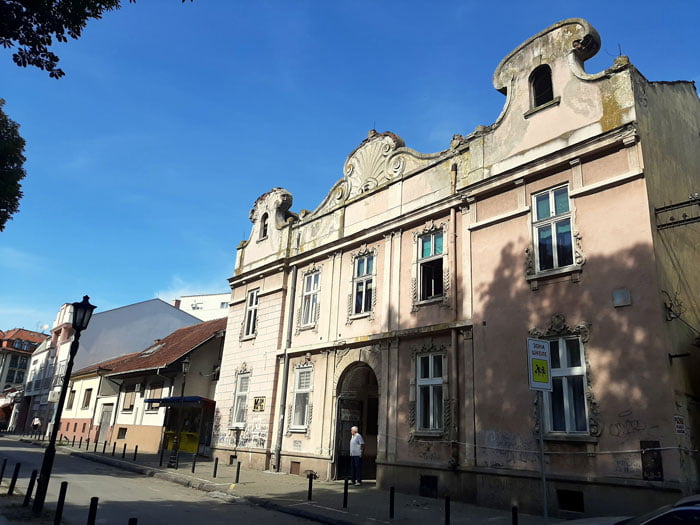
Kragujevac Old Church
This church, an endowment of Miloš Obrenović, was built in 1818 to mark the establishment of Kragujevac as the capital. Until 1859, Serbian Assembly sessions were held next to the church. It was here, in 1835, that approximately 2,000 parliament members and another 10,000 curious citizens from across the country gathered to vote for Serbia’s first constitution.
The church’s bell tower was designed by Jovan Ilkić, the same architect behind Belgrade’s National Assembly building.

One cannot help but feel a sense of history when stepping onto the same path Miloš Obrenović walked countless times. Inside the church, you can still see his chair adorned with the Serbian coat of arms and a small Ottoman turban engraving.
In the church courtyard stands another significant building: the first Serbian Assembly, built in 1859. Although it’s not open to the public and lacks visual appeal, its historical importance cannot be understated. Assembly sessions continued here even after the capital moved to Belgrade in 1841. During one such session in 1878, Jovan Ristić, a prominent Serbian diplomat born in Kragujevac, read the Berlin Congress statement officially recognizing Serbia’s independence.
This city has witnessed some of the most defining moments in Serbian history.
Amidža’s Konak
The Amidža Konak is the only preserved building from Miloš’s court complex and is now part of the Kragujevac National Museum. It was the residence of Sima Milosavljević-Paštrmac, one of Miloš’s most trusted noblemen, nicknamed “Amidža” (uncle in Turkish). The building was also known as the Boy’s House, as members of Miloš’s personal guard were stationed there.

The Amidža Konak provides a glimpse into what other parts of the court once looked like, such as Miloš’s Konak, destroyed during WWII bombing, or Ljubica’s (Šareni) Konak, which was lost in a fire.

Unfortunately, our stroll around the museum was after closing hours, so we didn’t get to go inside. Still, we passed by Prince Mihailo’s Konak, where the only Obrenović born in Kragujevac once lived. Unlike Amidža Konak’s traditional Turkish design, this house reflects Austrian architectural influences.
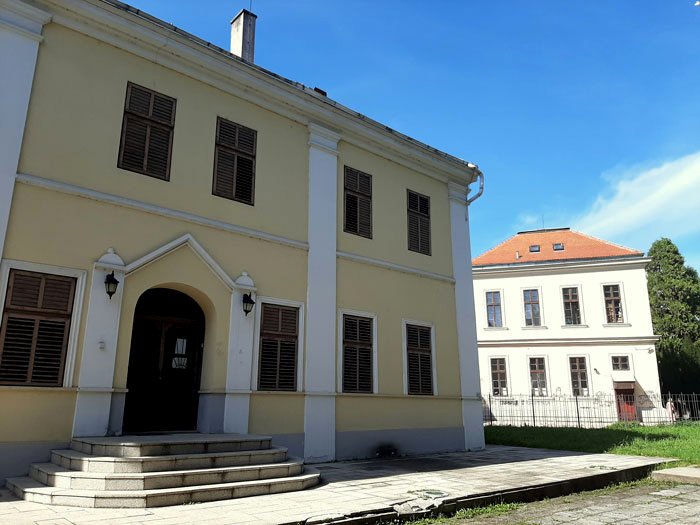
Miloš Obrenović also encouraged his noblemen to build residences beyond the court. Paštrmac followed suit, and his house, now private property, is visible from the street.

Nevertheless, if you’re curious about how these 19th-century houses were furnished, the Prota’s House within the National Museum is a must-visit. This residence belonged to Miloje Barjaktarević, a Serbian archpriest (prota) aligned with the left political wing. He hosted Svetozar Marković, an influential political activist and philosopher, who lived there for a while. While the house is built in a Balkan-Oriental style, the interior reveals how Serbian citizens in the mid-19th century began adopting European lifestyles.

Fashion magazines were delivered twice a month, and ladies dressed according to the latest trends. Inside Prota’s House, you can see authentic furniture, an old stove, kitchen utensils, and even the dishes once used by Marković.

Old Foundry
The Old Foundry Museum occupies the former Gun Foundry building, dating back to 1882, and is part of the Zastava Arms factory. This is the oldest preserved section of the arms factory, the first of its kind in Serbia. It was likely designed by a factory engineer who had studied in Germany. The museum’s collection holds over 5,500 artifacts.

The first Arsenal in Kragujevac Serbia was reportedly founded in 1836 as a small arms repair facility, which soon evolved into a full-fledged factory. The Gun Foundry was later constructed on the same site. The famous Bushing Plant is still visible here, notable as the location where the first light bulb in Serbia was used.

The area surrounding these historic buildings is often used as a movie set and also hosts the Arsenal Fest, a popular music festival held every June. Nearby, you’ll come across the Military Technical Institute building, erected in 1928 based on Belgian architectural designs. Known as the Administration Building, it still features an operational clock.

Adjacent to this building is a reinforced-concrete bridge, one of the first two constructed in Serbia, in 1923 and 1924. This bridge spans the Lepenica River, which was navigable during the time of Miloš Obrenović.

Kragujevac Grammar School
The first high school in Serbia was established in 1833 and later relocated to its current building in 1887. This institution boasts many renowned alumni, including Radomir Putnik and Jovan Ristić, while the celebrated painter and poet Đura Jakšić once served as a lecturer here.
Tragically, on October 21, 1941, many students and professors were taken from this school by German forces and executed. One of the classrooms has since been converted into a Memorial Classroom to honor their memory.

It’s evident that the Grammar School holds significant importance for Kragujevac Serbia—you simply can’t miss it. As Mrs. Mara recounts its history, I can almost imagine students from centuries past sitting on its steps, just as the youth do today.

Not far from this building stands another crucial 19th-century structure: the theater. Serbia gained autonomy with the Ottoman edicts of 1830 and 1833, granting the right to establish cultural and educational institutions. Since Kragujevac was then the capital, home to the Obrenović court, it became the birthplace of many Serbian firsts: the first newspapers, Novine Serbske, edited by Dimitrije Davidović; the first high school; the first theater, Knjaževsko-Srbski Teatar; the orchestra, Knjaževsko-Srbska Banda, led by composer Jožef Šlezinger; as well as the museum, library, court of justice, pharmacy, and more.

Several other landmarks deserve a place on your things to do in Kragujevac Serbia list. The Tržnica (market), that was under restoration, was the first covered market in Europe. At the city’s heart stands the Regent’s House, built in 1887 and used by Regent Aleksandar Karađorđević during 1914 and 1915.

The Court of Justice building, constructed in 1904, is another architectural highlight. It features a monument to Radomir Putnik in front, as this site served as the Serbian Army’s Supreme Command headquarters during World War I.

While exploring, make sure to admire the Cathedral Church, the art nouveau buildings along the pedestrian street, and iconic establishments like the Zelengora Hotel and Balkan kafana (a traditional Serbian restaurant). Zelengora, dating back to 1884, is one of Serbia’s oldest hotels. (I spent a couple of nights here.) Meanwhile, Balkan welcomes you with classic kafana musicians performing songs by the famous Serbian rock group Smak.

This comes as no surprise, considering Smak originated in Kragujevac Serbia, as Bojan Pavlović, the director of the City Tourist Organization of Kragujevac back then, proudly shares.
Nikola Koka Janković Legacy
The authentic architectural space houses the legacy museum dedicated to the memory of the Kragujevac sculptor, a renowned artist worldwide who left his work to the city of Kragujevac, Serbia. The museum contains more than 1,700 pieces, while the exhibition showcases 75.
Nikola Janković was a professor at Belgrade University and a member of the Serbian Academy of Sciences and Arts.

Alongside bronze pieces, you’ll find numerous plaster molds for sculptures displayed throughout the city (like the one of Radomir Putnik), as well as Janković’s early works. While our host, art historian Vladimir Marković, guided us through the Legacy exhibition, I couldn’t help but notice the Nikola Tesla monument—the same one I saw in front of Serbia’s first power plant in Užice Serbia, built according to Tesla’s designs. This sculpture can also be found in Kruševac, Belgrade, and New York.

Take some time to visit Đura Jakšić’s House as well. This great Serbian painter and poet lived and worked for a while in Kragujevac, Serbia. Today, the house serves as an exhibition area, while the cellar hosts the so-called Wine-Rakija Hub, where visitors can taste drinks from the region.

Voljavča Monastery
On the slopes of the Rudnik mountain, near the village of Stragari, lies the Voljavča Monastery. Its church, built in the early 15th century, holds significant historical importance as the site of the first Serbian government session in 1805, presided over by Matija Nenadović. Visitors can explore the memorial room dedicated to this pivotal event.

We were told how Nenadović complained to the First Serbian Uprising leader, Karađorđe, about being sent to such a “godforsaken place.” However, Karađorđe deliberately chose this remote location to keep it inaccessible to the Ottomans. The road to Voljavča wasn’t built until 1925. A kind nun guided us through the monastery, inviting us to rest and try their homemade liquor.

Another nearby monastery worth visiting is Lipar, located near the village of Donja Sabanta. Dedicated to St. George, it is also referenced in a few of Đura Jakšić’s poems. (Check out the Instagram stories I posted during my stay in Kragujevac. Click on the link to see everything else I explored.)

Memorial Park “October in Kragujevac”
At the entrance to the Memorial Park, you’ll find the “October 21” Museum, designed without doors or windows to symbolize the tragedy and despair of unarmed citizens facing German guns. The museum houses documents related to the 1941 massacre when German soldiers executed nearly 3,000 people, including children, in retaliation for their losses—10 soldiers killed and 26 wounded in battle. German General Franz Böhme ordered the execution of 100 civilians for every German soldier killed.
The park spans 352 hectares and includes 32 mass graves.
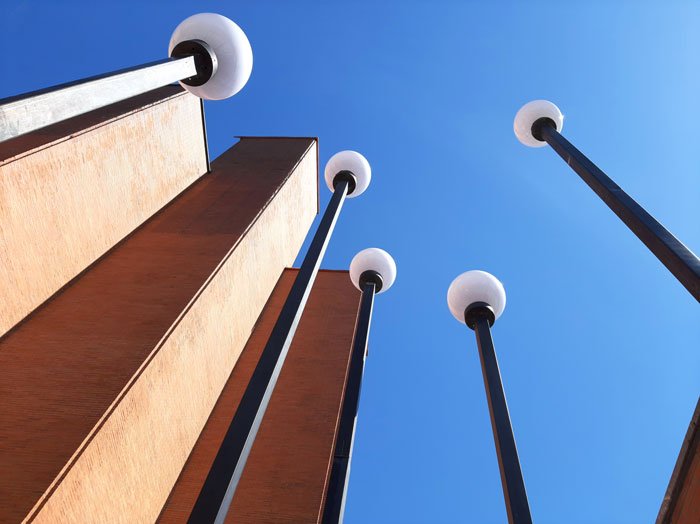
Memorial Park October 21 in Kragujevac, also known as Šumarice Park, is an essential site for anyone exploring Kragujevac, Serbia. This tragic chapter in the city’s history shouldn’t be missed.

Be sure to visit the “V/3” monument, commemorating the schoolchildren massacred here, or the haunting “Kameni Spavač” (Stone Sleeper) memorial.

Nearby, Šumarice Lake offers a space for summer relaxation, with swimming, lakeside restaurants, and an Adventure Park for entertainment.
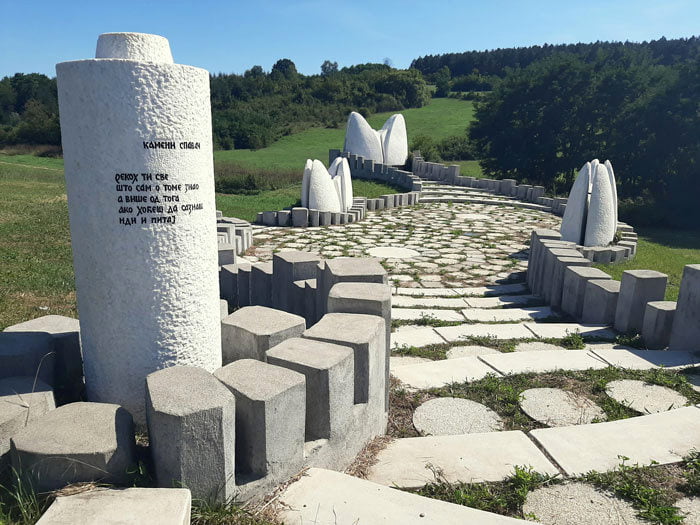
When heading to Voljavča, consider a detour to Cicić’s watermill. Despite arriving after breakfast, our host Miroslav insisted we try their offerings. He proudly explained that the mill has been in his family “since the great-great-great-grandfather of my great-great-great-grandfather bought it.”

Cicić mills wheat, buckwheat, and rye, but only their corn flour is available in local stores; the rest can be purchased directly on-site.
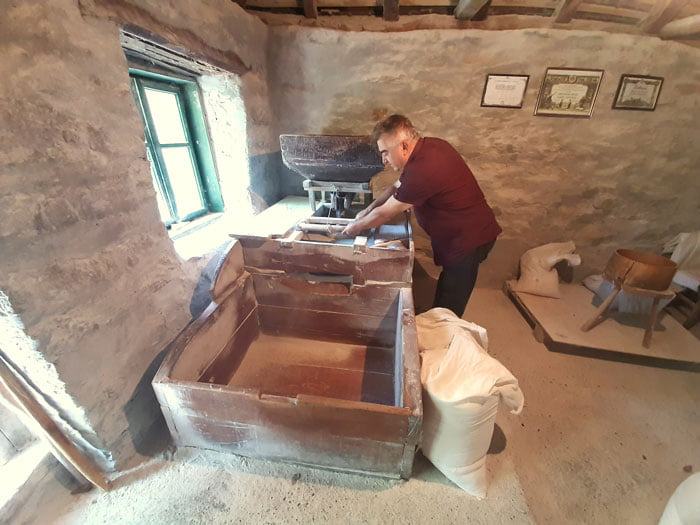
The traditional bun with kajmak, baked with three types of flour, was heavy but delicious, even on a hot day.

Although Kragujevac is primarily urban, rural tourism opportunities abound. One such experience is a visit to “Kočin Konak” (Koča’s House) in Gornja Sabanta, about 12 km from the city. This spot offers accommodations, fresh local products, and an authentic small area showcasing traditional tools.

Here, Mrs. Milanka, a friend of the owners dressed in traditional attire, showed us how to make homemade pie crust—and of course, we could try it afterward!
Speaking of local crafts, I must mention Suzana Gorjanac, whom I met in the city. She began weaving 15 years ago, and her scarves and capes are frequently exhibited both locally and internationally. Recently, she received an award in Belgrade for the best women’s woven hat.

When I first heard that the Šumadija region in Kragujevac, Serbia, is often compared to Italy’s Tuscany, I was skeptical. That is, until I visited the “Stari hrast” Wine Cellar (meaning “old oak tree” in Serbian). The winery, easy to find, is run by the warm and welcoming owners Zoran and Slavica, who are always ready for a friendly chat.

During our visit, a group of young people from Bosnia admired the landscape: a house called “trla” stands beside a centennial oak tree, next to the vineyard. This sacred oak, towering at 24-27 meters, adds charm to the picturesque scenery.

“Stari hrast” boasts 10 hectares of vineyards and 15 hectares of orchards. The best way to enjoy their wine and rakija is right there, beneath the ancient oak tree.

And one more thing for our “Things to do in Kragujevac” list. In the city center, I once had one of the best ice creams in Serbia, but unfortunately, that pastry shop later closed. However, during my next visits, I managed to find some delicious cakes instead. All it takes is a bit of exploring—just pop into the small shops. While strolling around, I always seem to end up stepping into a local boutique or two, and I inevitably bring home, well, another summer dress. It’s the kind you won’t find in Belgrade for sure, as these aren’t from big international retail chains but charming, family-owned shops. Take a walk and see for yourself!
Since Kragujevac is a true city in every sense of the word, you’ll find plenty of options for day-rent apartments in the city center (click here). I’ve stayed a few times with a view of the Grammar School, for example, or overlooking the other side of the Lepenica River. You can also choose accommodations outside of Kragujevac or even closer to Topola, giving you the chance to combine your stay with visits to other attractions in the wider area surrounding the city.
Next from the section: WEST SERBIA ATTRACTIONS
The full THING TO DO IN SERBIA section
PIN IT FOR LATER:


If you need a freelance travel writer or you would like to see your country, city, flight, etc., presented on the blog, drop me an email.
Find our more on Freelance Travel Writer page.
I am looking forward to working with you.




14 responses
Love how you describe all the historical places. You truly enjoy the journey and it shows. Believe me, that’s easy to spot when reading travel posts. ???? Kragujevac seems like a charming city to visit. ❤️
It really is charming, so important for Serbian history in general.
Thank you so much, it means a lot! 🙂
Thanks for this glimpse into the neighborhood! It reminds me on the fact that nearby locales, once we give them a chance, can be as exotic to explore as the faraway places of the world.
This Coronavirus situation urged me to explore my own country a bit more. And I still get surprised sometimes. 🙂
It’s so true that we tend to travel abroad to some distant lands forgetting our own treasures in the process that are so close and available. Thanks! <3
The history, culture, and traditions of KRAGUJEVAC are very interesting. I learned so much about the history of Serbia from your article. The stories about the victims of Nazis are heart wrenching. However, the fact that the nuns make a delicious wine made me smile. What a paradox! I loved the countryside, especially the watermill, Koča’s House, the vinery, and the hosts of these amazing places. Thank you for sharing your amazing experience!
I am so glad that you find the place interesting because that means that I managed to deliver the genuine experience. 🙂
Yes, Kragujevac is very important historically for Serbia but was also struck by some tragic misfortunes during its time, especially during WWII. The whole story is heartbreaking.
Also, it’s not that rare that liquers, herbal tea, etc., are made at Serbian monasteries. Nuns will often welcome you to sit and rest at the monastery complex, offering you coffee and some of their products to try. It’s almost a custom to accept and have a pleasant chat over a glass or a homemade cake. Serbian people in general are well known for their hospitality.
Thank you for stopping by! <3
I had no real idea of what to expect from Serbia, but you have done a great job introducing me to it. This looks like a lovely way to get an introduction. It is random that nuns make liquor. What did it taste like?
I was offered a herbal one and the one made of forest berries. I tried the herbal liqueur, it was sweet with a strong scent of mint. A nice drink, I have to admit, wouldn’t mind having a glass or two on some other occasion. 😀
Kragujevac looks lovely! So much to see and do and some great photos you took here 🙂 Thank you for sharing!
Thank you, so glad you like the photos. Some of those buildings were just stunning, even the photos didn’t do them justice. 🙂
What an excellent post! I feel like I was there. Thanks for sharing, now this is on my travel bucket list.
Oh, that sure is a compliment if you felt that way about the place because of my words. 🙂
Thank you! <3
Serbia really has some beautiful countryside. Maybe I missed it as I read, but what part of Serbia is this in?
This is the central part of the country. The main attraction here is the city itself with so many landmarks. But yes, Serbia is abundant in beautiful natural surroundings. 🙂